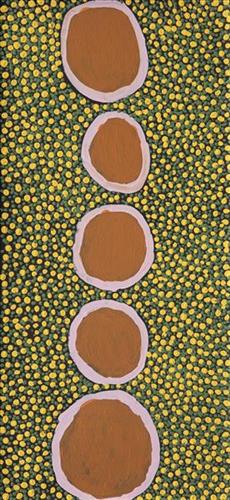111582383998
Jinyjiwirrily
Jinjiwirrily (jinyjiwirrily), otherwise known as kanyjilyi (wild gooseberry, or desert raisin), is a small, prickly shrub that produces spherical yellow bush fruit. The plant occurs in the spinifex sandplains and sand dunes of Australia’s arid regions. Usually the year after fire or good rains, jinjiwirrily prolifically produces purple flowers before fruiting. The fruit is high in vitamin C content and has a taste akin to tamarillo and caramel. It can be consumed raw when the fruit is yellow and ripe, but is generally preferred when dried like a raisin.
During the pujiman (traditional, desert dwelling) period, Martu would traverse very large distances annually in small family groups, moving seasonally from water source to water source, and hunting and gathering bush tucker as they went. Whilst desert life has moved away from mobile hunter-gatherer subsistence throughout the course of the twentieth century, bush tucker continues to be a significant component of the modern Martu diet. Hunting and gathering bush tucker remains equally valuable as an important cultural practice that is passed on intergenerationally. Though hunting and gathering implements have been modernised, methods of harvesting, tracking and the use of fire burning to drive animals from their retreats are still commonly practiced today.




